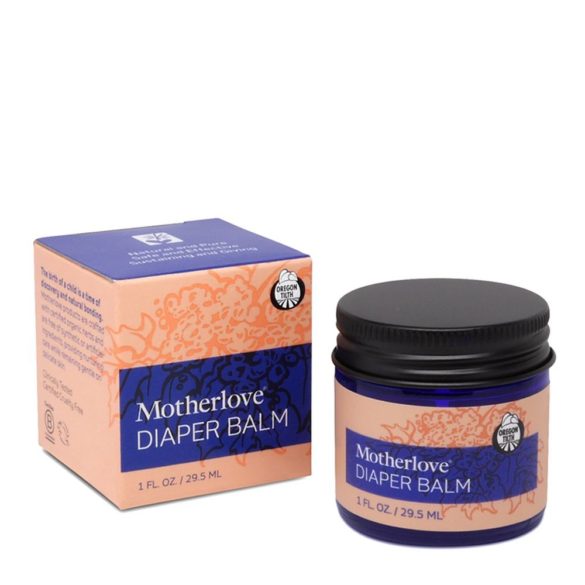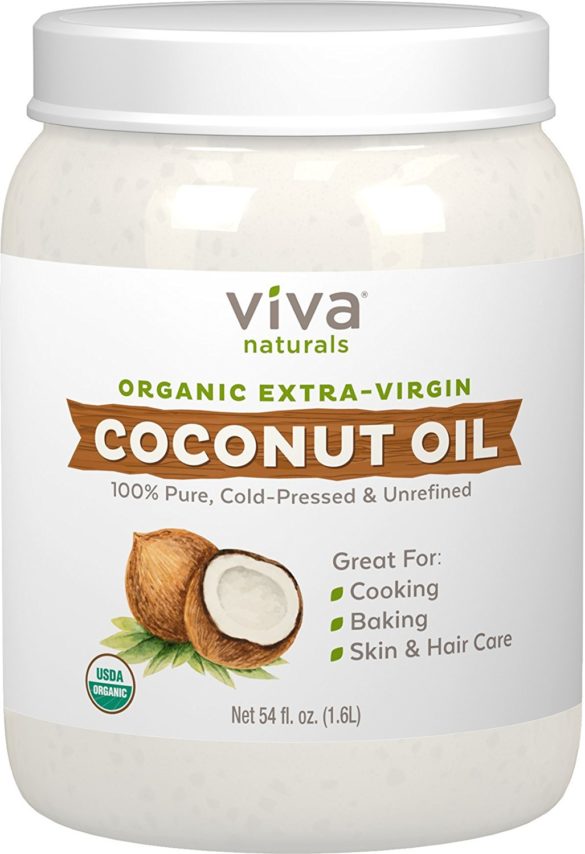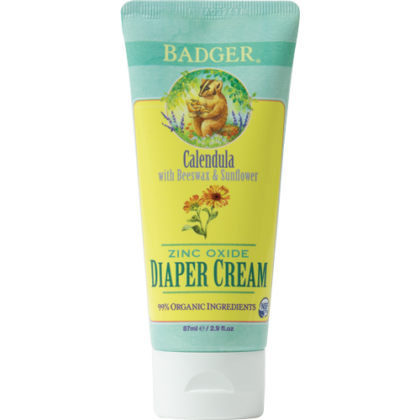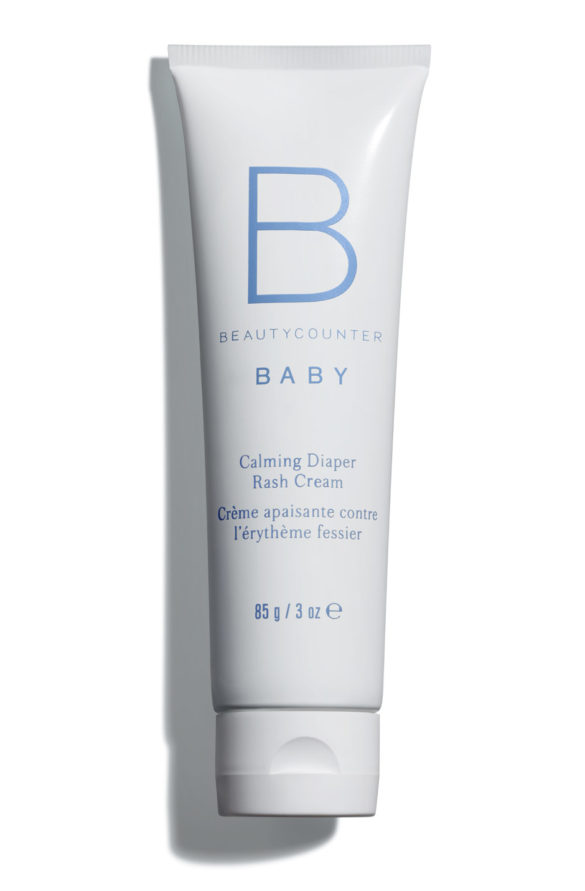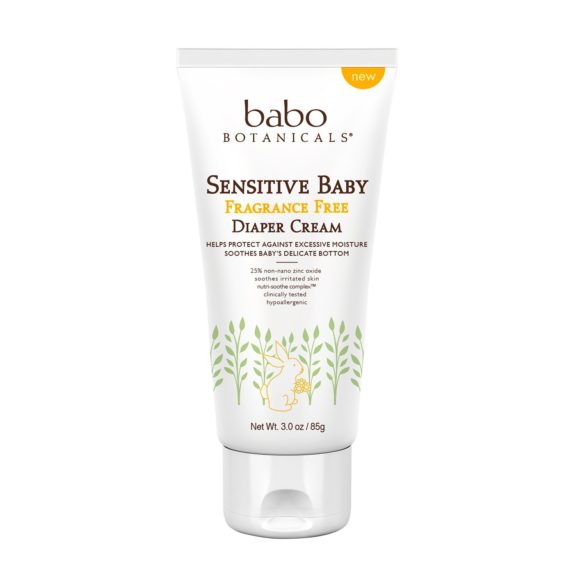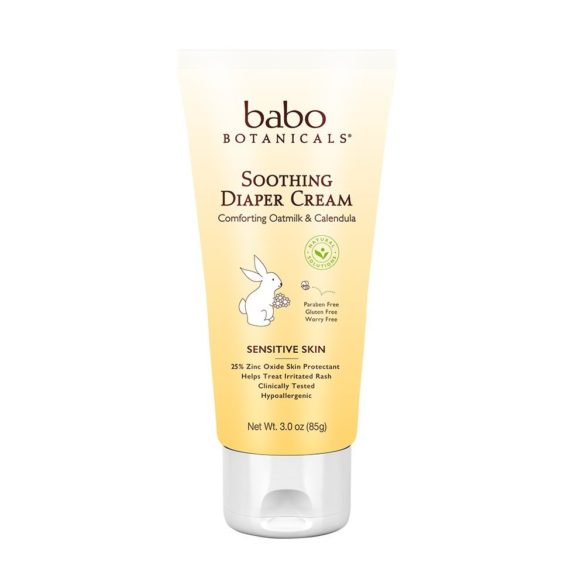Note: There is no one universal “best,” especially when it comes to parenting. These are “The Best Diaper Rash Cream” based on Also Mom's strict criteria, detailed here.
Even if you’re using the earthy-crunchiest of diapers (yes, even cloth), it’s likely that your baby will get a diaper rash of one kind of another at some point. And when that day comes, you’ll want to be armed.
Diaper balms made with zinc oxide, oils and waxes create a moisture barrier to help prevent new irritation, assuming you’re also curing the diaper rash source (friction, chemical sensitivity, food sensitivity, and/or wetness, all explained below).
Here's a little more about the best natural oil-based diaper balms, in loose order of preference:
- Motherlove Diaper Balm ($10.40/oz) – This stuff works, and it has absolutely zero sketchy ingredients (though it is only 96% organic). It has no detectable scent, is technically cloth diaper safe, and has an EWG rating of 1, the best rating possible. On the downside, it's pricey if you use a lot of diaper rash cream. [full review]
- Organic Coconut Oil (~$0.50/oz) – Although plain old coconut oil does not have some of the soothing ingredients added to other diaper balms (myrrh, calendula, etc.), it is a fantastic moisture barrier and will help heal diaper rashes almost or as well as other diaper balms. Plus, it’s super inexpensive! If you live somewhere colder, you'll likely have to warm it up in your hand before applying though, since it solidifies easily.
And here's a little more about the best zinc-oxide based diaper balms, in loose order of preference:
- Badger Zinc Oxide Diaper Cream ($4.48/oz) – An organic diaper cream that works like a charm with the help of zinc oxide, this product has no questionable ingredients whatsoever, is lightly scented (from natural ingredients), and contains no hydrogenated oils (unlike Babo Botanicals products). Beware the mess though: It does tend to liquify when warm. [full review]
- Beautycounter Baby Calming Diaper Rash Cream ($6/oz) – A great product for those who love zinc oxide-based diaper rash creams, this product works well, is mostly scent free, is mostly organic, and is free from questionable ingredients. [full review]
- Babo Botanicals Sensitive Baby Fragrance Free Diaper Cream ($3.98/oz) – This stuff works, even if it does smell a bit like old sunscreen thanks to the zinc oxide. Another downside? This product tends to become liquified when warm (think Texas heat), which makes it difficult and messy to use. Regardless, it's a great, safe diaper balm that is relatively inexpensive. [full review]
- Babo Botanicals Soothing Diaper Cream ($3.98/oz) – Very similar to Babo Botanicals Sensitive Baby diaper cream, this product is safe and works well but liquifies easily in heat. It has a few ingredients we don't feel certain about (though the EWG has no qualms) and a distinct, pleasant, calming scent, which comes entirely from natural ingredients. [full review]
We are also A-ok with 7th Generation Coconut Care Diaper Rash Cream ($2.49/oz) and Mustela 1.2.3. Diaper Rash Cream ($2.37/oz). Both of these creams are zinc oxide-based but do not use organic ingredients.
Also, if you are okay with using petroleum as your moisture barrier and don't mind forgoing organic ingredients entirely, Aquaphor ($1.50/oz), Boudreaux’s Butt Paste ($0.77/oz), Dr. Smith’s Diaper Ointment ($1.30/oz), and Triple Paste Medicated Ointment for Diaper Rash ($1.80/oz) all work, though personally we prefer natural alternatives.
Common Culprits of Diaper Rash
Here’s a little 411 on the common culprits of diaper rashes. Diaper creams and balms are great and all, but if you don’t get to the bottom (ha) of the issue, diaper rashes will persist.
The most common culprits of diaper rashes are friction, diaper or wipe chemical sensitivity, food sensitivity, illness, and occasionally, wetness. Let us elaborate.
- Friction: This one’s pretty obvious. If a diaper is too tight or is made from rough materials, friction rashes tend to be the result. These rashes are best remedied with a little rash cream, plus, of course, solving the core problem– the way the diaper fits. This might mean sizing up, changing brands, securing the diaper differently, or even something as simple as making sure you move all of baby’s tiny skin folds out of the way so they don’t become prime targets for friction rash.
- Diaper or Wipe Chemical Sensitivity: Some babies are sensitive to additives used in some brands of diapers and wipes. The common culprits are perfumes/added scents, chlorine, latex, and dyes. Luckily for you, we’ve already rounded up the best disposable diapers, the best cloth diapers, and the best baby wipes, all of which are free from harmful additives. If your baby is suffering from chemical sensitivity, consider switching to one of the options we recommend.
- Food Sensitivity: Persistent diaper rashes not caused from diaper or wipe sensitivity are usually caused by food sensitivities, either directly from something baby has eaten or indirectly through breast milk from something mom has eaten. The most common culprits are dairy (especially cow’s milk), soy, wheat, corn, eggs, and peanuts. Some babies are highly sensitive and will get diaper rashes with even the smallest amount of dairy (or dairy-infused breast milk). Others just need mom to cut back slightly. For more on food sensitivities, click here.
- Illness, Teething, Nerves: Illnesses, teething, and nervousness can all give baby runnier than normal poop, which tends to be more acidic and often causes diaper rashes. Moisture barriers (like the creams reviewed below) help while you wait for the phase to pass.
- Wetness: Going too long between diaper changes, especially when poop is involved, can cause diaper rashes. And regardless of the rash’s origin, when baby’s sensitive skin is constantly wet and doesn’t have the chance to dry properly, rashes are often made worse. When baby has a bad diaper rash, make sure to clean the area gently, apply diaper rash cream, then let baby’s bottom air out until it is completely dry. The more airtime, the better. To avoid wetness rashes, change your baby's diaper more frequently. (This is especially true with cloth diapers.)
What Makes a Great Diaper Rash Cream
To us, the best diaper creams…
- Work like a charm
- Are free from harmful chemicals and score as low as possible on the Environmental Working Group’s Skin Deep database (only 1s and 2s made the cut, and nothing with an ingredient rated higher than a 3 made the cut)
- Use natural oils and/or zinc oxide rather than petroleum to block moisture
- Smell nice or not at all with no added fragrances
What Didn't Make the Cut
There are a few popular diaper creams we do not prefer, for reasons stated below. These are those creams…
- Burt’s Bees Baby Bee Diaper Ointment ($2.65/ounce) – Rated a 3 on the EWG scale, this diaper ointment contains glyceryl rosinate (EWG 6), which is a skin toxicant and allergen.
- Cetaphil Baby Diaper Relief Cream ($1.75/ounce) – Rated a 3 on the EWG scale, this diaper ointment contains zinc sulphate (EWG 4) and propylene glycol (EWG 3). There are better options out there.
- Desitin Maximum Strength Original Paste ($1.30/ounce) – Rated a 4 on the EWG scale, Desitin contains fragrance (EWG 8), BHA (EWG 5), petroleum, and methylparaben (EWG 4), which are allergens and endocrine/hormone disruptors.
- Earth Mama Organics Organic Diaper Balm ($4.15/ounce) – Although this diaper balm is 100% organic, technically rated a 1 on the EWG scale, and works like a charm, it contains both lavender and tea tree oil. Although both of these oils are natural and organic, studies have shown they are endocrine disruptors, especially in little boys.
- Weleda Calendula Rash Cream ($3.00/ounce) – This is a beloved diaper rash cream that works well, but it contains lavender oil, which despite being “natural” contains chemicals known to disrupt hormones.
Note: There are also lots of natural, organic, indie diaper rash creams, ointments, and balms out there that tend to be priced higher than those creams we’ve reviewed above. If the ingredients look great, it will probably work well. We just happen to think spending more than $10 per ounce for booty balm is a bit absurd.
Featured image courtesy of @happyandgray.


